Iranian Regime Biggest Oppressor Of Media Freedom: Iranian Activist

Iranian prominent activist Masih Alinejad said at the UN that the leaders of Iran are the biggest oppressors of media freedom in the world.

Iranian prominent activist Masih Alinejad said at the UN that the leaders of Iran are the biggest oppressors of media freedom in the world.
On the occasion of the World Press Freedom Day, Alinejad told the UN General Assembly that she comes from a country where being a journalist is considered a crime and causes people to be imprisoned.
UNESCO has planned two major events in New York, including a global conference at the United Nations headquarters, to commemorate the 30th edition of World Press Freedom Day.
She further talked about the threats of the Islamic Republic against Iran International and other Farsi-language London-based media, saying that she proposes a resolution in this regard to condemn the international repressions of the Iranian regime.
Speaking about the Islamic Republic's fear of social networks, she added that Supreme LeaderAli Khamenei has restricted social media for people, but the government officials have accounts on the networks.
“I held up a picture of Mahsa Amini from the very same podium that butcher Ebrahim Raisi raised a picture of terrorist Qasem Soleimani in September. The picture of Mahsa Amini represents the real Iran. Raisi and Soleimani do not,” she said in a tweet.
The Islamic Republic through its propaganda tries to show ex-IRGC commander Qassem Soleimani as a national hero, but many people believe he was guilty of war crimes against civilians in Syria and spreading violence across the region.
She also slammed the imprisonment of Elaheh Mohammadi and Niloufar Hamedi, two journalists who reported the murder and funeral of Mahsa Amini, the 22-year-old Kurdish who was killed in police custody in September.

Iran International has obtained documents revealing that Iranian officials are aware of dangerous land subsidence but are unwilling to share it with the public.
On Saturday, Iran International television released its exclusive report about the issue, leaking a confidential letter from the country’s National Cartographic Center addressed to former agriculture minister Javad Sadatinejad, who was removed by President Ebrahim Raisi mid-April without announcing any concrete reasons.
In the letter, Ali Javidaneh an official at the center says that about 550 square kilometers of land in and around the capital Tehran (about the size of the UK city of Manchester or the US city of El Paso, Texas)is sinking an average of over 13 centimeters (about 5.12 inch) per year.
He said that parts of critical infrastructures in the area are affected by subsidence, adding that parts of the highway and the area’s power transmission lines as well as part of the railway pass through the affected areas.
According to another document with details about land subsidence across the country, 380 cities and towns and 9,200 villages are at risk of land subsidence and in some cases the entire area of the cities are located in the subsidence zones.

According to the data in the report,which was not made available to the public either, almost all the provinces of the country are affected by the issue. Bahreman, a city in the central province of Kerman, is on top of the list with 42 centimeters (about 1.38 ft) subsidence per year.
A day after the Iran International’s report, the National Cartographic Center unveiled a map of the country’s land subsidence during a geomatics event in Tehran.
Confirming our report, MasomehAmighpey, an official of the center, was cited by state media as saying that "In the assessments, we identified 245 subsidence prone areas, 30% of which have a high rate of subsidence." She added that 14 metropolises of the country are affected by land subsidence, and according to the statistics of the Energy Ministry, 70% of the country's plains are in crisis due to mismanagement.
Land subsidence is not limited to big cities with big construction projects. In many areas in Iran cracks and huge hollows that resemble meteor craters have appeared in the ground in recent years.
Experts say that over-extraction of ground water has led for cavities being formed underground which in turn lead to subsidence.
According to a report in March, the current level of land subsidence in Iran is “critical", with experts claiming it puts the lives of more than 39 million people at risk, about half of the country’s population.
Several factors have caused the situation to reach breaking point, including dam construction, climate change, inefficient water consumption by agriculture and industries, and the use of underground aquifers as sources for illegal agricultural water extraction wells.
Ali Beitollahi, heading the disaster task force on the issue at the Road, Housing and Urban Development Research Center of Iran, said the approximate area of subsidence zones in the country is now 18.5 million hectares, almost 11% of Iran's total area.
However, international reports claim the danger is even worse, nearing a humanitarian crisis. Science journal claims that more than 98% of Iran's 1.648 million km of land faces land subsidence.
Internationally, a rate of subsidence greater than 4mm (about 0.16 in) per year is considered a crisis and yet Iran's land is sinking at an astonishing rate of 6cm (about 2.36 in) per year in average as a result of 25 years of water level decline in the plains.
Ground subsidence in urban areas has resulted in power outages, bursting of gas pipes, deformation of rails, emergence of sinkholes, tilting of buildings, the appearance of cracks and ditches in roads and even loss of human life.Continued water level declines will reduce the ground's water permeability and turn fertile plains into barren deserts.

Iran is mulling the idea of selling the two southern islands of Kish and Qeshm and Khuzestan province to pay pensioners' arrears.
The director general of social insurance in Iran’s Ministry of Labor, Sajjad Padam, said: “Even if we sell two to three million barrels of oil with sanctions removed, we still cannot solve the pensioners' issues."
The Iranian government is facing a major challenge to pay pensioners arrears and raise minimum wage enough to meet the rising cost of living in a crippling financial crisis, leaving many elderly citizens without the money they need to survive.
The total amount of claims of pension funds by the end of 2020 was more than 501 thousand billion tomans (nearly 9 billion USD).
In recent months, protest rallies have been staged by workers and retirees in various cities to show anger at the regime's inability to address their issue.
According to the most recent census, there are nearly six million pensioners living in Iran. This number has been steadily increasing in recent years, as more and more people reach retirement age.
Iran’s retirement age is 60 for men and 55 for women but over half (55%) of senior citizens do not receive pensions and over one third (35%) of them live below the poverty line.
In 2021, The Supreme Audit Court of Iran said that 89% of retirees have a monthly salary of between 50 and 100 million rials (200 to 300 USD) which is believed to be much lower now since the rial tumbled to all time lows.

A US Jewish federation has slammed a letter by Israeli MPs to advocate for the separation of Iran’s Azarbaijan region, as most of the signatories rescinded their signatures.
In a joint open letter to Israeli foreign Minister Eli Cohen on Sunday, the Iranian American Jewish Federation of New York and Los Angeles called the letter signed by 32 members of the parliament (Knesset) “ill-advised”.
They have underlined that the authors of the letter are clearly misguided in thinking that such advocacy “will deliver a hard blow” to the regime in Tehran, which has been putting pressure on Azerbaijan since its opening of an embassy in Israel in March.
“This could further destabilize the region, create additional threats to Israel, and damage the current security structure to an irreversible and irreparable degree,” warned the federation, which claimed to support Iran’s territorial integrity.
The parliamentarians’ letter is further advocacy to deal a blow to Tehran and show support to its ally Azerbaijan but such meddling in the country’s foreign affairs has not been welcomed by Iranian Jews in the US.
The letter claims: “Any attempt, by any entity, foreign or domestic, to sever portions of the country will compel the Iranian people to rally around the flag. Any such entity will be considered an enemy of the Iranian nation, not just its government.”
In another part of the letter, it has been noted that although Iran has several ethnic regions, each with its own small separatist movement, any attempt towards the country’s fragmentation could result in the creation of radical and hostile states.
The US group asserted that the misplaced concern is not a matter for comment from the state of Israel, urging Cohen to publicly announce his stance on the matter.
Later on Tuesday, Israeli Intelligence Minister Gila Gamliel tweeted in Hebrew and Persian that she had “convinced most of the Israeli parliamentarians to rescind their signature from the letter.”
“Fighting against a religious extremist regime is the common desire of many nations, and we must always continue this way," Gamliel said, sharing a document with signatures of about 20 lawmakers who said they “express their disapproval of the establishment of a state in part of the territory of Iran for the Azeri minority.”
Earlier, Prince Reza Pahlavi and diaspora political group Solidarity for a Free Iran also slammed the letter.
The diaspora political group (7th Aban Front in Persian) said the Knesset members’ letter regarding “the Azeri minority” in Iran is “a clear case of action against Iran's existence”. “Solidarity for a Free Iran considers this letter a hostile act against the Iranian nation and strongly condemns it,” the statement said, adding that “the letter of these Knesset members is in sheer contradiction with the statements made by Israeli government officials regarding friendship between the two nations of Iran and Israel during the recent visit of Prince Reza Pahlavi,” Solidarity for Free Iran said.
“The verbal assault on Iran’s territorial integrity by 32 members of the Israeli parliament is completely unacceptable and a service to the interests of the anti-Iranian Islamic Republic regime,” Pahlavi said.
Following Cohen's recent state visit to Azerbaijan, the Knesset members asked the Israeli government to “pressure Iran to stop oppressing the Azeri minority in northwest Iran” and called for separation of what they called South Azerbaijan from Iran.

A case has been filed against two of Iran’s leading actresses who recently attended a ceremony without the mandatory hijab.
Tehran Police said Afsaneh Bayegan and Fatemeh Motamed Arya, legends of Iranian film and television, will now be investigated by the judiciary. If found guilty, the two women could face harsh prison sentences along with thousands of other protesters since September.
The case was filed after they appeared in public without the headscarf on Sunday night at a ceremony to honor actor Atila Pesyani.
At the ceremony, prominent Iranian cinema star Reza Kianian spoke of women’s right to refuse the headscarf, made mandatory since the Islamic Republic in 1979.
The government has refused to back down on its crackdown against the mass rebellion across the country, several businesses closed down for not enforcing rules imposed by the regime.
Celebrities and footballers supporting the protests have been singled out with businesses closed down, travel bans, bank accounts being frozen and restricting access to communications.
It comes after a wave of famous faces have used their social media accounts to voice their support for the protests that began in mid-September following the death of Mahsa Amini in police custody.
Many other artists and athletes, including popular Golab Adineh, Katayoun Riahi, and Pantea Bahram have also refused to wear the hijab in public and published photos of themselves casting off their headscarves on social media.

A former ally and now vocal opponent of the Supreme Leader says Ali Khamenei’s insistence on hijab enforcement is a bid to keep him popular among the hardliners.
Abolfazl Qadyani (Ghadyani), a staunch revolutionary in the 1970’s and 80’s and become a critic of Khamenei after the Green Movement, said in an article on Monday that the relentless hijab crackdown is “political haram”, branding the regime as “illegitimate rule”.
He coined the term “politically haram” from a speech given by Supreme Leader Ali Khamenei on April 4 when he said “discarding hijab is haram (sin) based on Sharia and also politically”, emboldening officials to embark on stricter measures.
Green Movement, also referred to as the Persian Awakening or Persian Spring by the western media, refers to a political movement that arose after the June 2009 presidential election and lasted until early 2010 in which people were protesting against the results of the rigged election that kept Mahmoud Ahmadinejad in office.
It was the biggest revolt against the regime until the current wave of uprising ignited by the death in custody of 22-year-old Mahsa Amini. Ahmadinejad’s main rival Mir-Hossein Mousavi has been under house arrest since 2011.
“His insistence on imposing hijab has only one reason: seeking legitimacy in the body of the religious-traditional part of Iranian society,” Ghadiani said.
The former revolutionary and an ex-comrade in arms of Khamenei said that the Supreme Leader "knows well that the achievement of his 30-year-old rule was nothing but the spread of poverty, injustice, corruption, and economic, political, and judicial banditry."
Ghadiani, who was a political prisoner both during the monarchy and the Islamic Republic, claims that Khamenei seeks to project this idea among a small fraction of the religious community, who still trusts the Islamic Republic is redeemable.

"Women whose hijab is not their personal choice will not give in to such an illegitimate and unreasonable whim, even if the regime growls and closes businesses and drags women and men to the court of justice," he said.
He and his comrades helped the clerics consolidate power 43 years ago. But he became a critic of Khamenei when in 2009 the Supreme Leader backed the disputed official results of the presidential election that kept Mahmoud Ahmadinejad in office, and triggered months of protests.
Ghadiani, who in the past believed in reforming the Islamic Republic, said earlier in the year that “Reforms are not possible,” arguing that the reform movement failed to produce any results in 25 years. “Ebrahim Raisi, an illiterate murderer has become president.”He also said that Islamic Republic’s ruling class “is unique in corruption and exporting corruption among its peers and tyrants around the world. They have turned religion into a tool for repression.”
Several figures who used to be proponents of the regime have started criticizing the Islamic Republic in recent months, especially following September 2022, when the “Women, Life, Freedom” movement began. The regime has killed well over 500 people and arrested nearly 20,000 protesters to prove that it did not kill Mahsa Amini.
Iran’s Sunni leader Mowlavi Abdolhamid, who has been delivering historic speeches every Friday in the past several months, said earlier in the day that "If the solution to people's problems is to arrest and detain, then arrest and imprison all of us.”
“If the people's problems are solved by arresting the protesters and politicians, I request them to hand themselves over to the prison so that the people's problems are solved," he said.